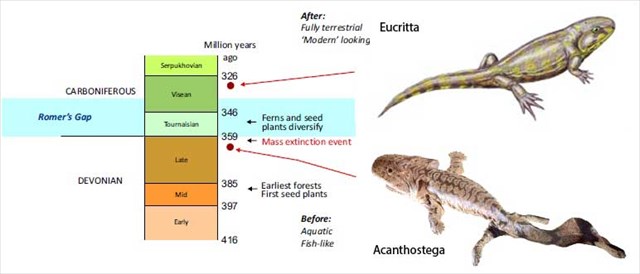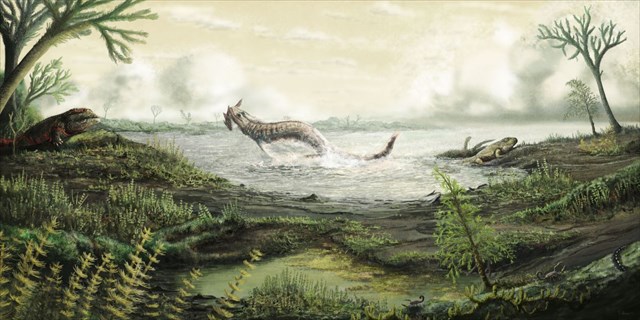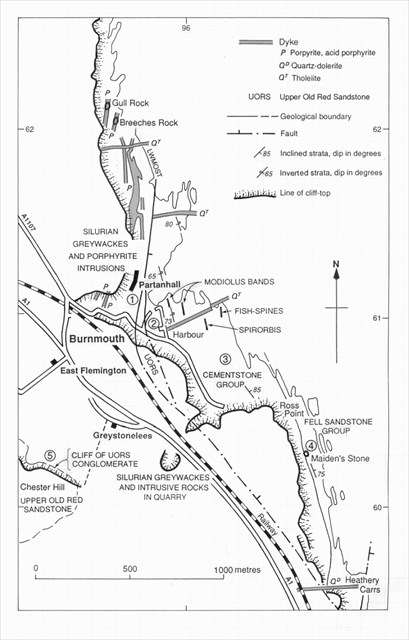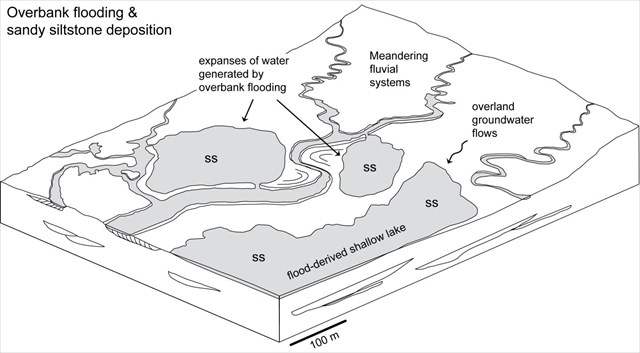Cache Notes
1. Answers must be emailed at the same time as posting a found log.
2. You will only be able to complete this cache at low tide, so check here before you go.
3. The road down into the harbour is very steep and narrow. Driving anything other than a car, such as a motorhome, is not advisable.
4. Do not remove any geological or fossil material from the beach, unless you have permission from Scottish Natural Heritage, as shown here.
5. Please note the terrain difficulty. You will have to scramble over some slippery rocks.
The rocks in Burnmouth Bay reveal strata from the Devonian (approx 360 million years ago [mya]) to the Carboniferious period (approx 340mya). The rocks on the North side of the harbour are from the older Devonian period, while the rocks further South along the bay are from the later Carboniferous period. In between, are rocks from a paleontological period known as ‘Romer’s Gap’ Significant fossil finds have occurred here in only the last few years, which will help explain the origins of animals we know today.
Romer’s Gap
Alfred Sherwood Romer (1894-1973) was an American Paleontologist and Biologist and a specialist in vertebrate evolution. He was the first to recognise the lack of fossil evidence during a 20 million period in between the late Devonian and early Carboniferous geological periods. This gap is extremely important as it represents the time when animals came out of the water onto land.
Until very recently, no one has identified a significant number of intermediate fossils, representing animals that made the transition from water to land. Theories as to why there is lack of evidence include the suggestion that oxygen levels were reduced in this period leading to a decline in the number of species. However, the TWeed Project demonstrated, by drilling a borehole in the local area, that there are layers of charcoal indicating forest fires which would only have been possible if oxygen levels were similar to today’s. A simpler explanation for Romer's Gap is that there are relatively few exposures of rocks from the period of the gap, and that those that exist have not yet been fully explored.

From TWeed Project
Tetrapods
A tetrapod is a vertebrate with four limbs, such as a reptile or amphibian, but also includes all living vertebrate animals. Tetrapod fossils from the Devonian period show aquatic creatures, often with 7 or 8 digits in their limbs, while Tetrapods found from the Carboniferous period are land dwelling animals, with 5 digits and an angle between the upper and lower part of the limb, allowing the arms and legs to project underneath the body, enabling land walking as opposed to paddling in water. The question is: what happened in between? The lack of a fossil record from this period has posed a significant challenge. The evolution of land dwelling Tetrapods is important, since all living vertebrates are descended from them. There is a lot of speculation about the evolutionary pressures that might have encouraged animals to move from a watery environment to solid land. They include the existence of large marine predators, or a change in the environment, such as reduced oxygen levels in the water, that made living on land preferable. The other fascinating question is: why do all land living vertebrates since this time have 5 digits (hooves are formed of 5 fused digits)?

From www.tetrapodworld.com
SE Scotland in the Devonian & Carboniferous Periods
This part of the world moved from about 25 to 10 degrees South of the Equator during the Devonian period. The rock formed during this period was sedimentary sandstone known as 'Old Red Sandstone'. The land mass continued to move North to around the Equator by the Carboniferous period. The area then was swampy and watery, prone to flooding and drought, and therefore Tetrapods, which died on land, are likely to have been washed into pools and lakes, thus preserving a fossil record of land-based animals.
The layers that built up over these millions of years have been tilted through 90 degrees here so that they are almost vertical, exposing the strata. The coastline here is famous for enabling James Hutton to collect evidence of the enormous length of the Earth’s history. Hutton’s work has shown us that high pressures and temperatures deep within the Earth causes the crust to warm and expand, resulting in the upheavals that causes rock stratifications to tilt and fold. More recently, we have understood the effect of tectonic plate movement contributing to movements in rock layers.
Burnmouth Bay affords an opportunity to examine rocks from different geological periods, from the old red sandstone to the newer early Carboniferous layers of Cementstone and Fell Sandstone, shown in the diagram. The diagram also shows a faultline, called the 'Berwick Moncline', a thrust fault which has caused movement in the rock.

From Burnmouth - an excursion
Fossil Formation
Fossils are formed when an animal dies and is buried, for example in mud or silt. Soft tissues decompose leaving hard bones or shells behind. Over time sediment builds over these remains and hardens into rock. It is important that this process takes place in an anoxic (no oxygen) environment. This explains why fossils of marine creatures are much more numerous in sedimentary rock than of land living creatures. A particular set of circumstances are needed for fossils of land creatures to form, such as a sudden mudslide or flood, causing animals to be buried quickly.

From www.tetrapodworld.com
Questions
To log this as a 'Find', please send answers to the questions below at the same time as posting your log. Failure to do so will result in your log being deleted without communication.
Walk between the waypoints to answer these questions:
1. At waypoint 1 you are looking at Old Red Sandstone from the older geological period. At waypoint 2 you are looking at younger rocks from the Cementstone part of the carboniferous period. Describe the differences between these two strata of rocks in terms of colour, hardness, angle tilt and composition.
2. Some of the rocks have been tilted through 90 degrees to expose the sedimentary layers. What do you think caused this to happen?
3. At waypoint 3 look at the cliff face. You can clearly see the layers of rocks where the topsoil has eroded and exposed the rocks. Describe the different layers (there are at least 4 types) and say how you think these have been formed.
4. Why are the rocks in Burnmouth Bay a good place to look for fossils?
5. What particular challenge is there in finding fossils in rocks lying at 90 degrees to the horizontal plane?
This earthcache was inspired by a talk given in March 2016 by Dr Nick Fraser, from the National Museum of Scotland, and a member of the TWeed project. Until August 14th 2016, there is a free exhibition at the National Museum of Scotland called 'Fossil Hunters: Unearthing the Mystery of Life on Land', where you can see some of the fossils that were excavated from here and other SE Scotland locations.
References
Lecture by Dr Nick Fraser, NMS, 'Spotlight on Fossils', 31/3/2016
Tweed Project (Tetrapod World: early evolution & diversification)
http://tetrapods.org/common/downloads/BGSOpenDayPoster2012.pdf
www.tetrapodworld.com
Romer’s Gap
https://en.wikipedia.org/wiki/Alfred_Romer
https://en.wikipedia.org/wiki/Romer%27s_gap
Fossil Formation
http://scienceviews.com/dinosaurs/fossilformation.html
Geology of Scotland
https://en.wikipedia.org/wiki/Geology_of_Scotland
http://earthwise.bgs.ac.uk/index.php/Burnmouth_-_an_excursion